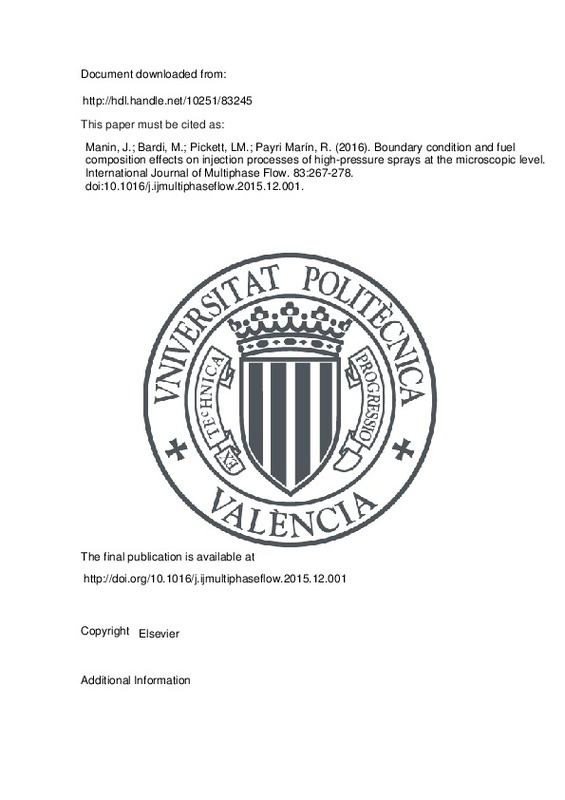JavaScript is disabled for your browser. Some features of this site may not work without it.
Buscar en RiuNet
Listar
Mi cuenta
Estadísticas
Ayuda RiuNet
Admin. UPV
Boundary condition and fuel composition effects on injection processes of high-pressure sprays at the microscopic level
Mostrar el registro sencillo del ítem
Ficheros en el ítem
| dc.contributor.author | Manin, J.
|
es_ES |
| dc.contributor.author | Bardi, M.
|
es_ES |
| dc.contributor.author | Pickett, L. M.
|
es_ES |
| dc.contributor.author | Payri Marín, Raúl
|
es_ES |
| dc.date.accessioned | 2017-06-20T08:47:54Z | |
| dc.date.available | 2017-06-20T08:47:54Z | |
| dc.date.issued | 2016-07 | |
| dc.identifier.issn | 0301-9322 | |
| dc.identifier.uri | http://hdl.handle.net/10251/83245 | |
| dc.description.abstract | Detailed imaging of n-dodecane and ethanol sprays injected in a constant-flow, high-pressure, high-temperature optically accessible chamber was per-formed. High-speed, diffused back-illuminated long-distance microscopy was used to resolve the spray structure in the near-nozzle field. The effect of injection and ambient pressures, as well as fuel temperature and composition have been studied through measurements of the spray penetration rates, hydraulic delays and spreading angles. Additional information such as transient flow velocities have been extracted from the measurements and compared to a control-volume spray model. The analysis demonstrated the influence of outlet flow on spray development with lower penetration velocities and wider spreading angles during the transients (start and end of injection) than during the quasi-steady period of the injection. The effect of fuel com-position on penetration was limited, while spreading angle measurements showed wider sprays for ethanol. In contrast, varying fuel temperature led to varying penetration velocities, while spreading angle remained constant during the quasi-steady period of the injection. Fuel temperature affected injector performance, with shorter delays as fuel temperature was increased. The comparisons between predicted and measured penetration rates showed differences suggesting that the transient behavior of the spreading angle of the sprays modified spray development significantly in the near-field. The reasonable agreement between predicted and measured flow velocity at and after the end of injection suggested that the complete mixing assumptions made by the model were valid in the near nozzle region during this period, when injected flow velocities are reduced. | es_ES |
| dc.description.sponsorship | The authors wish to thank Chris Carlen from Sandia National Laboratories for designing and manufacturing specific ultra-fast LEDs, as well as Jose Enrique del Rey and Juan Pablo Viera from CMT-Motores Termicos for their support during the experiments. Support for the research carried out by Julien Manin at CMT-Motores Termicos was provided by the U.S. Department of Energy, Office of Vehicle Technologies. Sandia is a multi-program laboratory operated by Sandia Corporation, a Lockheed Martin Company for the United States Department of Energy's National Nuclear Security Administration under contract DE-AC04-94AL85000. | en_EN |
| dc.language | Inglés | es_ES |
| dc.publisher | Elsevier | es_ES |
| dc.relation.ispartof | International Journal of Multiphase Flow | es_ES |
| dc.rights | Reserva de todos los derechos | es_ES |
| dc.subject | Injection | es_ES |
| dc.subject | Sprays | es_ES |
| dc.subject | Fuels | es_ES |
| dc.subject | Microscopy | es_ES |
| dc.subject.classification | MAQUINAS Y MOTORES TERMICOS | es_ES |
| dc.title | Boundary condition and fuel composition effects on injection processes of high-pressure sprays at the microscopic level | es_ES |
| dc.type | Artículo | es_ES |
| dc.identifier.doi | 10.1016/j.ijmultiphaseflow.2015.12.001 | |
| dc.relation.projectID | info:eu-repo/grantAgreement/DOE//DE-AC04-94AL85000/ | es_ES |
| dc.rights.accessRights | Abierto | es_ES |
| dc.contributor.affiliation | Universitat Politècnica de València. Departamento de Máquinas y Motores Térmicos - Departament de Màquines i Motors Tèrmics | es_ES |
| dc.contributor.affiliation | Universitat Politècnica de València. Instituto Universitario CMT-Motores Térmicos - Institut Universitari CMT-Motors Tèrmics | es_ES |
| dc.description.bibliographicCitation | Manin, J.; Bardi, M.; Pickett, LM.; Payri Marín, R. (2016). Boundary condition and fuel composition effects on injection processes of high-pressure sprays at the microscopic level. International Journal of Multiphase Flow. 83:267-278. https://doi.org/10.1016/j.ijmultiphaseflow.2015.12.001 | es_ES |
| dc.description.accrualMethod | S | es_ES |
| dc.relation.publisherversion | http://doi.org/10.1016/j.ijmultiphaseflow.2015.12.001 | es_ES |
| dc.description.upvformatpinicio | 267 | es_ES |
| dc.description.upvformatpfin | 278 | es_ES |
| dc.type.version | info:eu-repo/semantics/publishedVersion | es_ES |
| dc.description.volume | 83 | es_ES |
| dc.relation.senia | 311880 | es_ES |
| dc.identifier.eissn | 1879-3533 | |
| dc.contributor.funder | U.S. Department of Energy | es_ES |







![[Cerrado]](/themes/UPV/images/candado.png)

